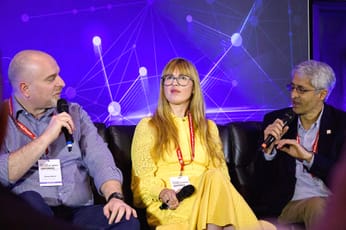Reinventing the TV experience #ftmedia12
David Abraham, chief executive office, Channel 4
TV networks need to find their own way through the three definitions of network: the traditional view of TV networks, the network as in networked computers, and the network as in the social network… How do you do this? Identify the audience more tightly, personalise content for them and then use those as optimised channels.
Viewers no longer silently consume our content – they talk back. The first step is to ask them to register to join the conversation. We’re investing in creating a viewer relationship programme. They’ve signed up >2m demographically profiled viewers. They’re seeing changes already – over 50% of video on demand users are now logged in. The new cookie laws are a challenge, but he sees it as an opportunity for a more transparent conversation with the viewers.
They’ve been recruiting a team from outside broadcasting to make use of their data. Soon, they’ll be offering recommendations based on their preferences. A proportion (undisclosed) are already actively managing their accounts – they expect that to grow as they add more incentives to do so. And they’re experimenting with “social recommendations” to understand how to engage with readers on social networks. And the database of viewers and their preferences should allow much better ad targeting. They’re engaging with ad agencies around interactive ad formats and other innovations.
Channel 4 is launching a new channel 4Seven which replays the most buzz-causing programmes from the last week. “Not an algorythim – mix of social media buzz, and traditional ratings measure”.
Panel Discussion
- **David Abraham
** - **Patrick Barwise, Emeritus Professor of Management and Marketing, London Business School
** - Anthony Wood, Founder and Chief Executive Officer, Roku
- Andrew Fisher, Chief Executive Officer, Shazam Entertainment
Abraham: the past is not necessarily a guide to the future – the technology can now pass back information on behaviour, which it couldn’t do before. If all devices are connected, it will change the business models. Online viewing is still in low single digitals – but the growth is there. But these things are decade-long spans.
Barwise: We use these words like “linear” – we look at homes with 100s of channels, with broadband, with DVRs – they’re still watching the same programmes from the same channels from the DVR, and catch-up with the VoD. It’s linear TV, just more convenient.
Wood: The number of hours on a Roku player is up to 12 hours a week right now. Usage is growing rapidly. The things that consumers find interesting are choice. The internet provides many more choices. Customers like watching television on television – but they like choices of prices and programmes.
Fisher: Half the advertisers in the superbowl this year had Shazam-enabled their ads. 1m people interacted with that advertising. (Hold phone up, it recognised the ad, launches additional content on the second screen.)
Abraham: the important thing is that the second screen ensures that TV advertising isn’t a blunt instrument. It’s not about all of the people doing this all of the time, it’s about some of the people doing it all the time.
Barwise: It’s all evolutionary. We will still have TV channels in five years’ time – but we see lots of interesting things around the edges. Social media is more relevant to small channels, by creating buzz around their programmes.
Fisher: We’re big believers in social media. It’s very hard to market to the younger demographic without it. There’s a social currency in being the first to tell your friends about a cool new show – a badge of honour.
Wood: the advantage of social media is recommendation – the Netflix app will share what you’re watching to your Facebook account, letting your friends see what you’re watching. For us, the photo and video aspects of Facebook are interesting to bring to your TV.
Abraham: We’re building a new railroad system. We’ve put some new stations and tracks in, but we’re not sure quite where it will end up when it’s done. TV is clearly getting more responsive and interesting.
Wood: There are different sorts of shows. There are the ones they want to watch live – sports, gameshows – and those they want to watch on demand. There are shows where there will be a game component, but the majority will be entertainment-based and time independent. You’ll see the home page of smart TV platforms like Roku become the new TV guide. Recommendation engines work a lot better across the whole range of content than just one provider.
Barwise: recommendation will happen, but it’s much harder than, say, books. The audience is less segmented, and you’re only dealing with 28 hours a week.
Wood: the most common thing people do with second screens is look up the names of actors, etc.
My comment:
The whole session had a distinct feel of “it’s all fine, it’s all fine, the changes aren’t that great, just a bit of useful evolution”. And I think of Bill Gates’s quote about how technology tends to change things less than you expect over two years, and far more over 10. I might be an edge case, but my wife and I haven’t had a conventional TV for 18 months – we use a large computer screen hooked up to my Mac, and play content from iTunes or various on demand/catch-up services. I think more of that is coming than many people may be prepared to admit. Are we going to see a split between the passive consumer in front of the TV and the active consumer in front of a connected screen?
Sign up for e-mail updates
Join the newsletter to receive the latest posts in your inbox.








